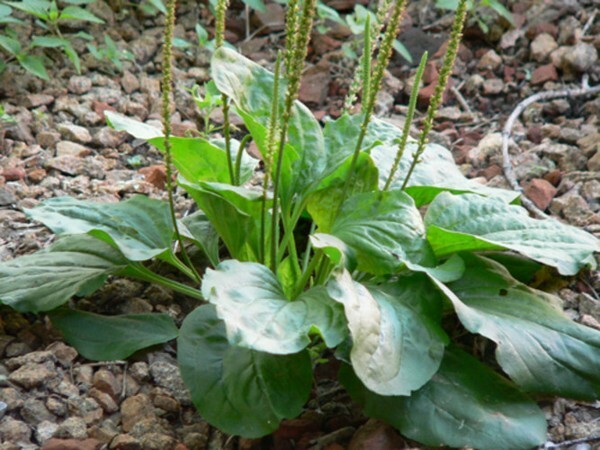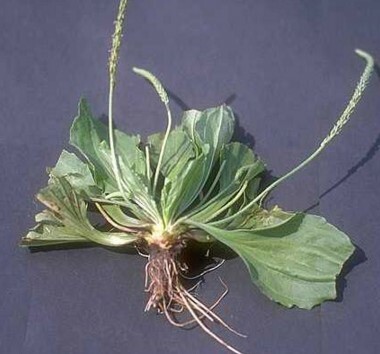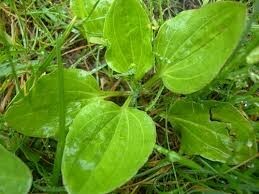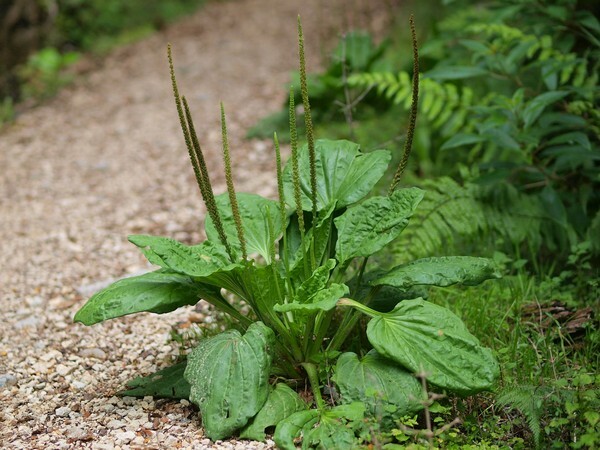Contents:
- Botanical description of plant
- Chemical composition of plantain roots
- Procurement of raw materials
- Therapeutic properties of
- Methods of application
- Precautions
Everyone knows about the medicinal properties of plantain. Many remember how, as a child, they themselves or their parents put on the wound and abrasions fresh leaves of this ubiquitous grass as a first aid for stopping bleeding, disinfecting, relieving pain and inflammation. Plant genus Plantain numbers more than 200 species. Some of its representatives have long been used in folk medicine to treat violations of integrity and inflammatory processes on the skin, diseases of the gastrointestinal tract and upper respiratory tract. The therapeutic effect of plantain is recognized and official medicine, it is used to make syrups and candies that help with coughing of various etiologies. As medicinal raw materials, the plant leaves are mainly used, but the plantain root and seeds also have medicinal properties.

Botanical description of the plant
Plantain is a perennial herbaceous plant that can be found in the temperate zone almost everywhere: on wastelands, along roads, near houses, in gardens and gardens, in parks, countryside, along the banks of reservoirs. The widespread ubiquity of this herb is due to its undemanding conditions of growth and easy reproduction by seeds, which can adhere to the sole of shoes, paws of animals, feathers of birds and be carried to various places in this way.
In plants of this genus, there is a short thick vertical rhizome of brown color, from which numerous thin cord-like roots of yellowish color leave in the form of a dense bundle. They provide a reliable retention of the plant in the ground.

Interestingly: Native Americans often carried with them a powder from the plantain root to protect against snakes and snake bites. Due to its ability to draw a snake venom from the wound, the plant was also called "snake grass".
The leaves are large, with arched venation, located on the petioles and form a basal rosette. Flowering plant from May to September. Flowering arrows are deciduous, erect, come out of the center of the root rosette of leaves. The flowers are plain, very small, sessile, forming a dense spicate inflorescence on the top of the peduncle. The fruits appear in August, they are multi-seeded boxes. The plantain is polluted by the wind, multiplies by seeds.
Chemical composition of plantain roots
Compared to leaves, the roots of plants do not have such a rich chemical composition, but, nevertheless, it is also very valuable and causes the presence of medicinal properties. In the roots of plantain contains the following active compounds:
- linoleic acid;
- allantoin;
- cholesterol;
- phytosterols( stigmasterol, sitosterol, campesterol);
- mucus;
- carbohydrates( starch, dextrose, sucrose);
- wax;
- traces of tannins.
Linoleic acid is an essential fatty acid and is a necessary component for normal functioning of the body. Allantoin, found in the leaves and roots of plantain, has an anesthetic, astringent and anti-inflammatory effect.
Phytosterols perform close to cholesterol functions, are able to normalize blood levels, and also reduce the risk of developing tumorous diseases of the stomach, lungs, ovaries and mammary glands. They are responsible for maintaining the structure of the cell, slow down the process of age-related decline in collagen production and enhance its synthesis, so the means based on them are actively used in cosmetology for skin care.
Procurement of raw materials
The preparation of plantain roots is often produced together with leaves. The most valuable medicinal properties are the plants located far from automobile roads in darkened places.

For the production of raw materials, the whole plant is excavated together with the root. Then it is separated with scissors, cleaned of adhering soil, washed, cut into small pieces and dried in a draft under a canopy, spreading a thin layer on fabric of natural material. The degree of drying is determined as follows. If the top layer is well removed while carrying the nail along the root surface, it means it has completely dried out. Keep dry plantain root should be in tissue pouches no more than 2 years. It has a slightly sweetish-salty taste.
Important: If you only need to collect the leaves of the plant, then they are carefully cut with scissors, trying not to damage the roots, so that they have the opportunity to grow again.
The healing properties of
The healing properties of the plantain help to cope with a variety of diseases, since the preparations based on it are characterized by a multifaceted action. The plant has the following types of biological activity:
- anti-inflammatory;
- is bactericidal;
- regenerating;
- analgesic;
- is mucolytic;
- hemostatic;
- sedative;
- antiallergic.
Despite the fact that the plantain root in folk medicine is used much less often than other parts of the plant( leaves and seeds), it is quite effective in a number of diseases.
Interesting: The history of the plantain plant as a medicinal plant has more than 2500 years. It was known to Hippocrates, Dioscorides, Galen, Avicenna and other ancient doctors and philosophers.
Outwardly appliqués from the fresh crushed root of plantain and leaves help with elephantiasis and edema on the legs. Extract and powder from the root of the plant as a wound-healing and antiseptic agent are used after bites of insects, wasps, bees or vipers, as well as for the treatment of ulcers. This tool helps to relieve pain and prevents the appearance of swelling and swelling. It is also an antidote for snake bites.
A decoction of the plantain root is done by rinsing with toothache, inflammatory processes in the oral cavity, sore throat and pharyngitis. When toothache is effective and alcohol tincture of the roots. With inflammation of the gums for the removal of pain, redness and strengthening them, just slowly chew a piece of the cleared root in the mouth until the intensity of pain sensations decreases. Putting a piece of psyllium root wrapped in gauze into the ear cavity helps to remove the pain in the ear. Also this remedy works well with toothache, for this, the root should be placed in the ear on the side where the tooth hurts.

In inflammatory processes in the kidney and bladder, polyuria as part of a complex treatment is taken inward by a decoction prepared from the seeds, leaves and roots of the plant. Extract and tea from the roots of plantain can be a useful remedy for the elimination of fever, intense cough and cough treatment against tuberculosis. Means from the dried root of plantain are used in the treatment of diseases of the endocrine glands, in particular the thyroid gland and adrenal glands.
Psyllium root can help women to reduce blood loss in case of heavy menstruation, and men can increase their potency and cure infertility caused by low activity of spermatozoa. They use it in folk medicine and infectious diseases. Tincture on red wine from the aerial parts of the plant and the root is effective for herpes. In ancient times the plantain root was used to treat infectious mumps, hanging it around the neck.
Ways of using
The plantain root for treatment can be used fresh and dry. Compresses, decoctions, infusions and powder are made from it.
Infusion for elephant disease
In case of abnormal growth of the skin and subcutaneous tissue, accompanied by congestion and edema in the lower limbs, the following recipe helps. The mixture of the aerial part and root of the plantain( 330 g) is poured with a liter of boiling water, boiled for one minute, insisted for an hour and filtered. The resulting infusion is taken in 100 ml 6 times a day.
Herpes remedy
Roots from three plants are ground, ground into a homogeneous mass, poured 300 ml of a mixture of dry red wine and pure spring water, prepared in a ratio of 1 to 1. Use this agent 50 ml 3 times a day until complete recovery.
Tea for cold and flu
A mixture of dry or fresh leaves, roots and psyllium seeds is poured in 200 ml of boiling water, it is insisted 10 minutes. If desired, add sugar or honey. They drink during the day.
Broth for diseases of endocrine glands
1 cup of boiling water is added to the finely ground roots of the plant( 1 tbsp.).The resulting mixture is kept in a boiling water bath for 5-10 minutes, allowed to cool to room temperature, filtered and taken 15 ml three times a day.Water root extract with tuberculosis
Finely chopped roots( 1 tbsp.) Pour 1 l of boiling water, heat on minimum heat for 10 minutes, insist for 24 hours, then filter. Take three times a day for 15 ml 15 minutes before meals.
Precautions
Means from the root of plantain are usually well tolerated and do not cause side effects. At some people at internal reception it is possible a vomiting, disturbances of a chair, a pain in a stomach. Just like any other plant, plantain can cause an allergic reaction in the body, so you need to be careful.
Despite the fact that there are some differences between the medicinal properties of leaves, seeds and the medicinal properties of the plantain root, contraindications for all of them are identical. This plant can not be used to treat people with the following problems:
- stomach diseases with increased secretion of gastric juice;
- increased blood clotting;
- exacerbation of gastritis or ulcers;
- individual intolerance.
You should not take money from the root of the plantain to children, pregnant and lactating women.
Important: Plantain is used for various diseases, but before starting treatment with its leaves, seeds or roots, consult your doctor.
On the medicinal properties of plantain:
